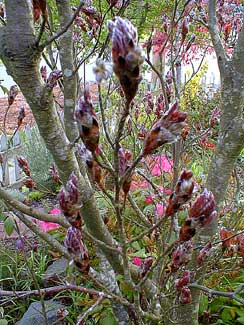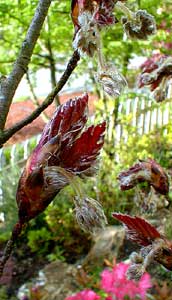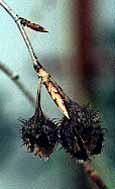
Rohani Beech; aka,
Purple Oakleaf Beech; aka,
Rohan European Sawtooth Beech; aka,
Fern Leafed Copper Beech
"When russet beech-leaves drift in air,
And withering bracken gilds the ling,
And red haws brighten hedgerows bare,
And only plaintive robins sing;
When autumn whirlwinds curl the sea,
And mountaintops are cold with haze,
Then saddest thoughts revisit me,--
I sit & dream of the olden days."
-George Francis Savage-Armstrong
(1845-1906)
(1845-1906)
Growing in the front yard on the opposite side of a walkway from a paperbark maple, & kitty-corner from a green weeping beech, is our Rohani European beech.
Rohani beech has a strong upright stance, especially when young, broadening with age. It has wavy-fringed purple leaves with lobes reminiscent of oak leaves. The variety originated in 1894 in Bohemia, when purple-leafed A. sylvatica 'Atropunicea' was crossed with oak-leafed F. sylvatica 'Quercifolia.' It can grow 35 to 50 feet & potentially larger, typically achieving a 20 foot spread. Growth rate is an impressive one to two feet a year.
 It likes humousy acidic soil kept evenly moist (neither too droughty nor too wet) in full sun (but can tolerate a bit of shade), suitable for zones five through eight. It's cold-hardy to minus fifteen, but adverse to warmer climates. It is very resistant to diseases & insect attack.
It likes humousy acidic soil kept evenly moist (neither too droughty nor too wet) in full sun (but can tolerate a bit of shade), suitable for zones five through eight. It's cold-hardy to minus fifteen, but adverse to warmer climates. It is very resistant to diseases & insect attack.It will not often require pruning, but if it does, this can be done either summer or autumn. Their extensive root systems should not be disrupted once established, & most specimen trees are container-grown because beech cultivars might not otherwise transplant well. Their roots are also adverse to compacted soil, for which reason they're not good roadside trees, but should be central to woodland garden settings.
 Leaves turn coppery or bronzed in autumn, as can be seen on the Rohani Page of the Autumn Trees Gallery. The upright limby structure & speckled/mottled bark make the Rohani beautiful even leafless in winter, as can be seen in a photo of the trunk & limbs on the Rohani Page of the Winter Bark Garden Walk.
Leaves turn coppery or bronzed in autumn, as can be seen on the Rohani Page of the Autumn Trees Gallery. The upright limby structure & speckled/mottled bark make the Rohani beautiful even leafless in winter, as can be seen in a photo of the trunk & limbs on the Rohani Page of the Winter Bark Garden Walk.The edible Beechnuts are one-inch light brown fruits enclosed in a prickly or fuzzy-looking husk, quite liked by large birds & by squirrels & deer. When the husk splits open & drops the fruit, the husk remains behind like a tree decoration often clinging the whole winter long, as shown in a February photo here at the left.
The leaves when they first emerge are accompanied by furry blossoms, barely visible in the first mid-April photograph at the top of this page showing the still-folded emerging leaves with a bit of white fuzz which is the flower. At this stage they're almost like pussy-willow pussies on steroids! The second portrait shows the fuzzy flowers "at full dangle" drooping from the rapidly developing leaves. I read one commentary on the Rohani which insisted that the flowers were an unimportant feature, but I strongly disagree. They are quite wondrous, lending a snowy silvery glow throughout the purple foliage.